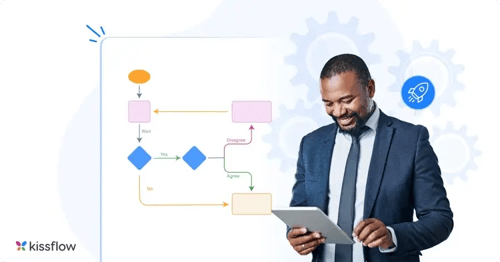
- >
- BPM Software >
- Business Process Reengineering: Boost Efficiency & Profits in 2026
Business Process Reengineering: Boost Efficiency & Profits in 2026
When incremental improvements to your order fulfillment process still leave customers waiting weeks for delivery, or when your "streamlined" hiring process still takes three months to bring on critical talent, you've hit the limits of process optimization. Sometimes the most efficient path forward requires admitting that existing processes are fundamentally flawed and starting fresh. As an experienced technology leader, you recognize when Band-Aid solutions won't fix structural problems. McKinsey's 2024 Operations Excellence Study shows that organizations undertaking comprehensive process reengineering achieve 60 percent performance improvements compared to just 15 percent from incremental optimization efforts.
What is business process re-engineering (BPR)?
Business Process Reengineering (BPR) is the comprehensive redesign and reconstruction of business processes to achieve dramatic improvements in productivity, cycle times, quality, and customer satisfaction through fundamental analysis, elimination of non-value activities, and radical process transformation rather than incremental enhancement.
Learn More: Business Process Management (BPM)

Unlock the Power of Comprehensive BPM Tools: Scale, Succeed, and Stay Ahead
Thank you for downloading!
Is business process reengineering (BPR) same as business process improvement (BPI)?
On the surface, BPR sounds a lot like business process improvement (BPI). However, there are fundamental differences that distinguish the two. BPI might be about tweaking a few rules here and there. But reengineering is an unconstrained approach to look beyond the defined boundaries and bring in seismic changes.
While BPI is an incremental setup that focuses on tinkering with the existing processes to improve them, BPR looks at the broader picture. BPI doesn’t go against the grain. It identifies the process bottlenecks and recommends changes in specific functionalities. The process framework principally remains the same when BPI is in play. BPR, on the other hand, rejects the existing rules and often takes an unconventional route to redo processes from a high-level management perspective.
BPI is like upgrading the exhaust system on your project car. Business Process Reengineering, BPR is about rethinking the entire way the exhaust is handled.
Learn more: Process building software.
Five steps of Business Process Re-engineering (BPR)

To keep business process re-engineering fair, transparent, and efficient, stakeholders need to get a better understanding of the key steps involved in it. Although the process can differ from one organization to another, these steps listed below succinctly summarize the process:
Below are the 5 business process re-engineering steps:
1. Map the current state of your business processes
Gather data from all resources–both software tools and stakeholders. Understand how the process is performing currently.
2. Analyze them and find any process gaps or disconnects
Identify all the errors and delays that hold up a free flow of the process. Make sure if all details are available in the respective steps for the stakeholders to make quick decisions.
3. Look for improvement opportunities and validate them
Check if all the steps are absolutely necessary. If a step is there to solely inform the person, remove the step, and add an automated email trigger.
4. Design a cutting-edge future-state process map
Create a new process that solves all the problems you have identified. Don’t be afraid to design a totally new process that is sure to work well. Designate KPIs for every step of the process. Consider platforms for approvals and workflows to streamline processes.
5. Implement future state changes and be mindful of dependencies
Inform every stakeholder of the new process. Only proceed after everyone is on board and educated about how the new process works. Constantly monitor the KPIs.
Learn more: Process automation solutions
A real-life example of BPR
Many companies like Ford Motors, GTE, and Bell Atlantic tried out BPR during the 1990s to reshuffle their operations. The reengineering process they adopted made a substantial difference to them, dramatically cutting down their expenses and making them more effective against increasing competition.
The story
An American telecom company that had several departments to address customer support regarding technical snags, billing, new connection requests, service termination, etc. Every time a customer had an issue, they were required to call the respective department to get their complaints resolved. The company was doling out millions of dollars to ensure customer satisfaction, but smaller companies with minimal resources were threatening their business.
The telecom giant reviewed the situation and concluded that it needed drastic measures to simplify things–a one-stop solution for all customer queries. It decided to merge the various departments into one, let go of employees to minimize multiple handoffs and form a nerve center of customer support to handle all issues.
A few months later, they set up a customer care center in Atlanta and started training their repair clerks as ‘frontend technical experts’ to do the new, comprehensive job. The company equipped the team with new software that allowed the support team to instantly access the customer database and handle almost all kinds of requests.
Now, if a customer called for billing query, they could also have that erratic dial tone fixed or have a new service request confirmed without having to call another number. While they were still on the phone, they could also make use of the push-button phone menu to connect directly with another department to make a query or input feedback about the call quality.
The redefined customer-contact process enabled the company to achieve new goals.
- Reorganized the teams and saved cost and cycle time
- Accelerated the information flow, minimized errors, and prevented reworks
- Improved the quality of service calls and enhanced customer satisfaction
- Defined clear ownership of processes within the now-restructured team
- Allowed the team to evaluate their performance based on instant feedback
–> Here are 6 more real-world business process management examples.
When should you consider BPR
The problem with BPR is that the larger you are, the more expensive it is to implement. A startup, five months after launch, might undergo a pivot including business process reengineering that only has minimal costs to execute.
However, once an organization grows, it will have a harder and more expensive time to completely reengineer its processes. But they are also the ones who are forced to change due to competition and unexpected marketplace shifts.
But more than being industry-specific, the call for BPR is always based on what an organization is aiming for. BPR is effective when companies need to break the mold and turn the tables in order to accomplish ambitious goals. For such measures, adopting any other process management options will only be rearranging the deck chairs on the Titanic.
Core questions
Before you decide to adopt BPR for functional reshuffling, ask yourself the following questions:
- Who are our customers? What values are we offering them?
- Are the current processes delivering expected values?
- Do the processes need to be redefined or redesigned?
- Are the processes in sync with our long-term mission and goals?
- How would we handle the existing processes if we were a new company?
If a company concludes that it is, in fact, operating on complacent grounds, it has to identify the right kind of solution to address the problem or consider BPR for a total overhaul. Done well, BPR’s radical approach yields dramatic results for a company in terms of improved cycle times, product quality, productivity, and so on.

Good BPM reduces the need for BPR
The productivity of employees definitely takes a hit during process reengineering. Changes are difficult to manage, and it saves a lot of costs on analysis, reengineering, and documentation. If processes are managed better during runtime, the need for reengineering is greatly reduced. Modern business automation software enables teams to move beyond manual, repetitive tasks and focus on work that drives real value. It acts as a central hub where workflows, data, and collaboration come together for greater efficiency and accuracy.
Kissflow is a low-code platform that allows you to create, streamline, and digitize processes with minimal coding. You can directly create new processes from scratch or improve new processes with the visual drag-and-drop editor.
The powerful reporting capabilities of Kissflow make it easier to monitor process performance, identify efficiency issues, and make data-driven decisions to reengineer processes for improved efficiency. With Kissflow BPM software, you get a lot more visibility into processes and their functions.
Process Owners, Process Heads, and Process Managers must ensure smooth and efficient workflows. Automating processes with a low-code platform enhances agility and accuracy. Discover how Kissflow helps process owners.
See how Kissflow platform can simplify your workflow automation.
FAQs - Business Process Reengineering
1. What are the main phases of business process reengineering?
BPR typically starts with thorough process identification and mapping to understand current operations. Next comes analysis to identify inefficiencies and opportunities for improvement. The redesign phase reimagines processes from scratch with customer value in mind. Implementation introduces the new processes, while continuous monitoring ensures sustained performance improvements.
2. How can automation enhance BPR?
Automation supercharges BPR by eliminating manual handoffs that slow processes down. RPA bots handle repetitive tasks while AI tackles complex decision-making that previously required human judgment. Process mining tools automatically discover inefficiencies that might be missed in manual analysis, creating a data-driven foundation for redesign efforts.
3. What companies have successfully implemented BPR?
A major automotive manufacturer reduced its accounts payable department by 75% through BPR. More recently, a global engineering conglomerate transformed its product development process, cutting time-to-market by 58%. A leading insurance company reengineered its claims handling, improving customer satisfaction while reducing processing costs by 30%. These successes share common threads of leadership commitment and employee involvement.
4. What are common pitfalls in business process reengineering?
Many BPR initiatives fail because they focus exclusively on technology without addressing underlying organizational issues. Inadequate change management dooms even well-designed processes when employees resist adoption. Setting unrealistic timeframes creates pressure that leads to shortcuts, while failing to align reengineering with strategic objectives results in isolated improvements rather than transformative change.
5. What is the role of AI in business process reengineering?
AI transforms BPR from periodic big-bang projects to continuous evolution. Process mining powered by machine learning constantly analyzes performance data to suggest improvements. Intelligent automation handles increasingly complex tasks, freeing humans for creative work. Natural language processing extracts insights from unstructured data, revealing improvement opportunities in customer interactions that structured data misses.
6. When should enterprises choose BPR instead of small process improvements?
BPR is needed when processes are fundamentally broken—highly manual, slow, costly, or misaligned with business goals. Incremental fixes won’t solve structural inefficiencies.
7. How does BPR reduce long-term operational costs?
By eliminating redundant steps, restructuring decision paths, and redesigning workflows around outcomes instead of legacy habits.
8. What role does automation play in successful BPR?
Automation ensures redesigned processes stay consistent, measurable, and scalable. Without automation, BPR typically regresses.
9. Why do BPR projects fail in enterprises?
Failures often come from weak change management, unclear ownership, lack of governance, or digitizing without true redesign.
10. How does BPR improve customer or employee experience?
Reengineered processes reduce waiting time, confusion, and unnecessary handoffs—making experiences smoother and faster.
11. How should CIOs measure BPR impact?
Track reduced cycle time, fewer exceptions, higher throughput, compliance improvement, and user adoption.
Related Articles











